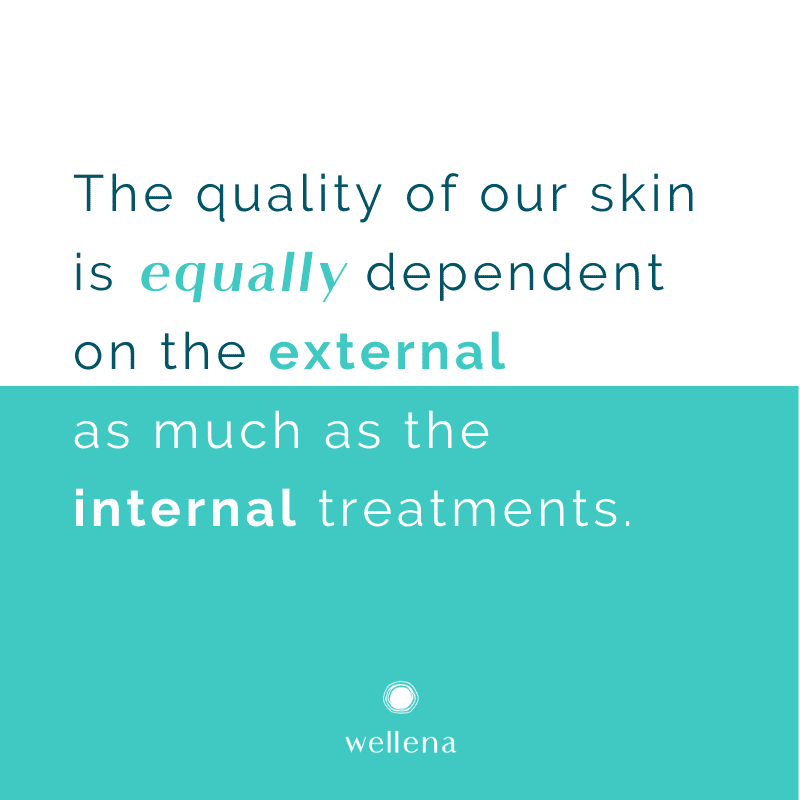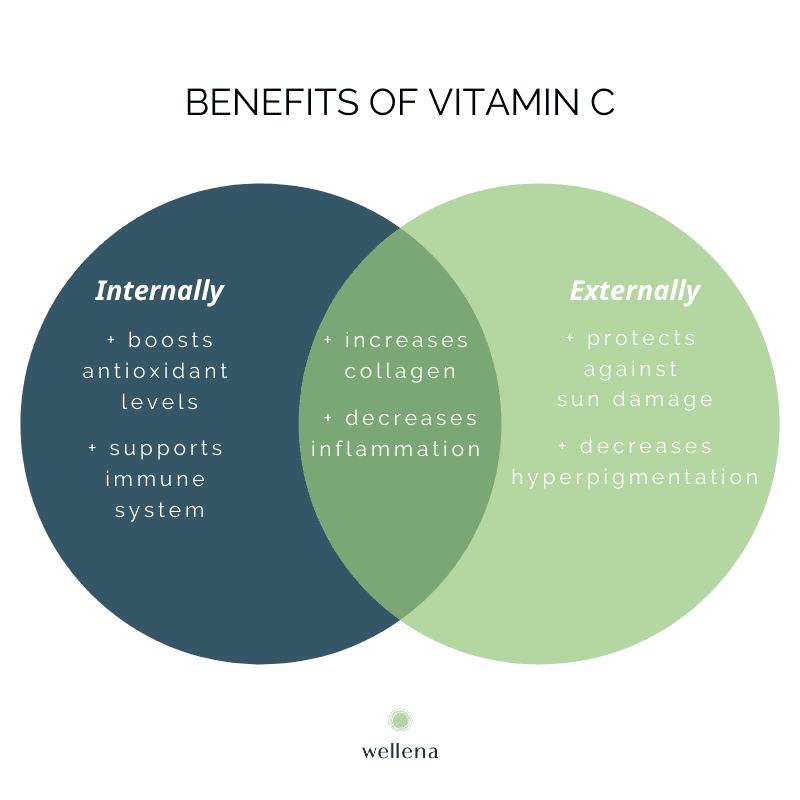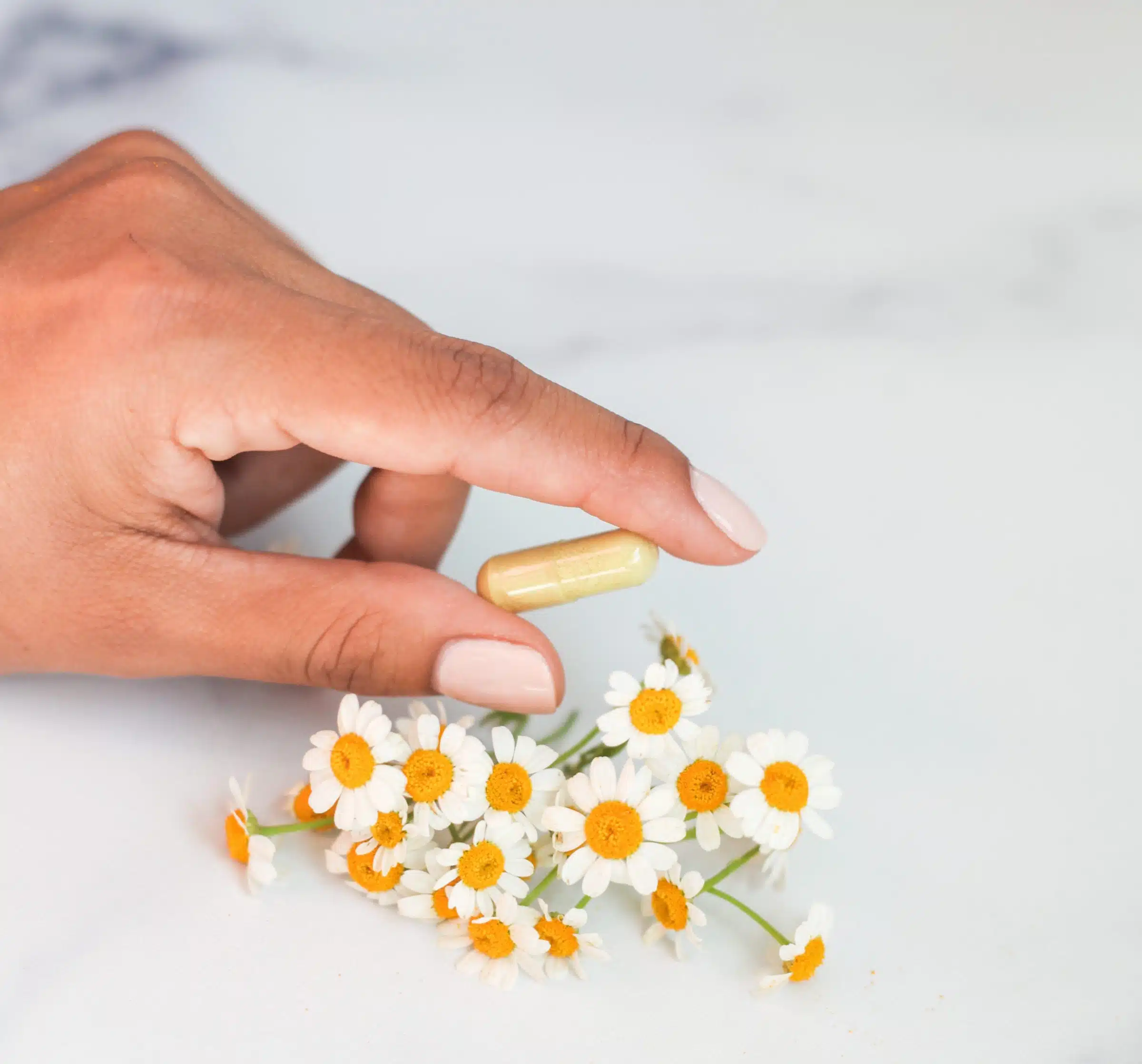What You Will Learn in This Article
- Why Your Skin Needs Internal and External Nutrition
- 4 Benefits of Vitamin C for Skin Health
- How to Amplify Vitamin C Internally
- How to Use Vitamin C Topically
- What I Recommend
My Own Struggles with Skin, Cystic Acne and Scars
I absolutely hated my skin as a teenager and young adult. It was constantly inflamed and covered with cystic acne – not only on my face but also my back, chest, and even buttocks. I tried every acne product. I drank and applied every herb that claimed to reduce acne. Instead, the products caused my skin to become drier and more damaged. I wore shirts and dresses that covered my acne, and it had a profound impact on my self-esteem, especially when it came to dating—I avoided it completely as a teen.
Everything changed when my friend Soraya asked me to be her bridesmaid and tailored beautiful open-top dresses for the bridal party. I knew I had to do something about my acne or else I won’t go to the wedding wearing this dress. Poking around the internet generated illuminating results: Food such as gluten, dairy, and eggs were often the root cause of acne. Mind you, this was circa 1998 when the internet was just picking up and there were no resources like there are today. I was puzzled by this finding but also compelled to learn more.
A food sensitivity test showed that I had an IgG food intolerance to gluten, dairy, and eggs. Bingo. I cut them out and my acne cleared out within a couple of weeks. The painful dryness went away as well. The blemish spots and scars took several months but they all eventually cleared. No single product could fix my cystic acne until I changed my diet and lowered my overall inflammation.
Your Skin Needs Internal and External Nutrition
This was the moment I realized that the quality of our skin is equally dependent on the external as much as the internal treatments. Cutting out inflammation will improve the skin. Eating foods (or taking high-quality supplements) that will flood the body with nutrients such as vitamin C, vitamin A, and collagen will improve it. Applying moisturizing ingredients such as aloe or nourishing oils such as shea or jojoba will help, too. It’s not one or the other. If you want healthy skin, you need to treat it both internally and externally.
Skincare companies have us conditioned that if you want plump and glowing skin, topical products are the only way to achieve that. This is only partly true. Eating inflammatory foods or ones you have a sensitivity to, will cause overall inflammation in the body and your skin is the visible result of that. Remember, your skin is largely a reflection of your inner health.
In today’s article, I want to bring your attention to vitamin C and the profound effects it can have on your skin when used internally and externally.
My fascination with vitamin C has turned me to develop a skincare line that nourishes your skin externally. We also have a few food and supplement suggestions to replenish your vitamin C levels internally as well.
The complete vitamin C skin solution: Internal and external!
Vitamin C for More Than the Immune System
Vitamin C is known as the vitamin of the immune system. We all reach for it when we feel like we’re coming down with something. It works so well partly because it’s a powerful antioxidant that helps fight inflammation. For that same reason, vitamin C is great for healing, repairing, and protecting your skin.
4 Benefits of Vitamin C for Skin Health
The benefits of vitamin C would be enough to fill an entire book on the topic. Here, we’ll focus on four health benefits of vitamin C that are specific to the skin.
Increases Collagen Production
Vitamin C is excellent for skin health, helping you age gracefully, as it is vital for the production of collagen. This is key for a youthful complexion, since collagen production decreases as we get older, leading to fine lines, wrinkles, sagging skin, and bags under the eyes.
The good news is that vitamin C (ascorbate) stimulates the synthesis of all different collagen types as it donates the electrons needed to convert precursors into different types with the help of specific enzymes.
Vitamin C can help with collagen production both internally, through diet or supplements, and externally, by a topical application. The topical application of vitamin C is considered very promising in dermatology. In fact, a 5% topical vitamin C cream was shown to reconstitute collagen within the skin and significantly improve skin structure, including softening, reducing wrinkles, hydrating, and brightening.
Decreases Inflammation and Redness
Inflamed, irritated skin can be painful and impact our self-confidence. According to studies on supplemental and intravenous vitamin C, this nutrient may help lower inflammation in the body.
In a randomized controlled trial of 64 obese patients with diabetes or high blood pressure, the treatment group was given 500 mg of vitamin C twice a day. Those receiving vitamin C had significantly reduced inflammatory markers, including C-reactive protein, after 8 weeks of treatment.
In another study, IV vitamin C given at a high dose of 7.5 grams up to 50 grams was helpful for reducing inflammation.
Now, this does not mean you need such high levels of vitamin C. A dosage of 1200 mg per day is plenty to keep your skin and immune system happy.
What occurs inside the body (inflammation) can’t help but manifest in our external appearance in many ways.
Oxidative stress from a poor diet, metal toxicity, mold toxicity, sleep loss, and more sets off an inflammatory marker called nuclear transcription factor kappa B (NFkB), which leads to inflammation and aging skin. Vitamin C has been shown to inhibit NFkB and shows promise for skin conditions such as acne and rosacea.
As it soothes inflammation, vitamin C can tame red, irritated skin and restore a clear, smooth complexion.
Aging Gracefully with Vitamin C
If you have hyperpigmentation from past sun exposure, tanning, or some type of inflammation, vitamin C can help.
While the pigment melanin in our skin is supposed to increase with exposure to sunlight to prevent damage, sometimes it remains and causes areas of hyperpigmentation. These are known as “sun spots,” “age spots,” or “liver spots.”
Vitamin C has been shown in studies to inhibit melanin production, which then decreases the look of “age spots.”
In a clinical study of patients with melasma, a 25% topical formulation of vitamin C was used along with a chemical penetration enhancer. After 16 weeks’ treatment, there was a significant decrease in hyperpigmentation.
Note: Taking vitamin C as a supplement never hurts, but in this case, a topical application would be best.
Protects Us From Sun Damage
Not only can vitamin C help repair past damage from the sun—it can also help protect against future damage. We know that the sun with its UV radiation is damaging to our skin when exposed for too long, contributing to premature aging, hyperpigmentation, and even skin cancer.
A robust body of scientific literature supports the use of vitamin C topically in skin care, as it protects against the effects of both Ultraviolet A and B. The fact that it’s a powerful antioxidant means that vitamin C can combat free radicals as they’re generated, putting a stop to any potential damage. Why wait until the harm is done? Make sure to optimize your vitamin C both inside and out.
How to Amplify Vitamin C Internally
Food Sources of Vitamin C
Kakadu plum
Kakadu plum (Terminalia ferdinandiana) is a super food that comes to us from Australia. You may have never heard of it, but it is by far the richest source of vitamin C that we know of at 3,000% of your daily vitamin C needs from just 3.5 ounces of the fruit.
Unless you’re headed to Australia soon, you’re going to find kakadu plum in the form of a superfood powder, which you can add to a smoothie or a breakfast bowl.
Amla
Amla (Emblica officinalis Gaertn. or Phyllanthus emblica Linn) is otherwise known as Indian Gooseberry. It’s considered the most important medicinal plant in Ayurvedic medicine and is traditionally used to treat common colds and fever, plus a number of other ailments, including digestive disorders. Amla has high levels of vitamin C at 478.56 mg per 100 ml, which is more than you’ll find in citrus fruits like lemons, oranges, or tangerines.
For its outstanding vitamin C profile, amla is the main source of vitamin C used in our new skincare line, Wellena, which I talk more about below.
You find it in the form of a powder, a juice, or as dried berries, which may be sweetened with quite a lot of sugar. Or, you may be able to find fresh berries at an Indian grocery store near you.
Camu camu
Camu camu (Myrciaria Dubia) is a tart berry that originally comes from the Amazon Rainforest. Due to its popularity as a super food in the last couple of decades, and to preserve the Rainforest, it’s now being grown on large plantations.
Not a lot of research has been done on camu camu yet; vitamin C calculations are being estimated, and vary according to where the plant is grown. However, according to current nutrition labels, a teaspoon of camu camu powder may provide 682 mg of vitamin C, which is 760% of the recommended daily value.
Camu camu is sour like lemons, so products are often sweetened to make them palatable. You can add camu camu powder to smoothies, breakfast bowls, overnight oats, and salad dressings. Because it’s tart like lemon powder, you’ll want to balance it with other flavors.
Acerola Cherries
Acerola cherries (Malpighia emarginata) are a tropical fruit that are also known for their high vitamin C content. A half cup (about 49 grams) of acerola cherries provides 822 mg of vitamin C, which is 913% of the recommended daily value. Acerola cherry powder is available to add to smoothies, and you can also find it as a juice.
Rose Hips
Rose hips are the fruit of the rose bush. They are rich in vitamin C, with just 6 rose hips providing 119 mg of vitamin C, which is 199% of the recommended daily value.
Rose hips are included in my recipe for an Immune-Boosting Syrup called Oxymel. You can also enjoy it as a delicious jam substitute by making a simple and healthy Flavonoid Bomb, or you can take it in the form of a supplement.
Black Currants
Black currants (Ribes nigrum) are a widely available food source of vitamin C. When eaten raw, a half cup of these nutritious fruits provides 101 mg of vitamin C, which is 169% of the recommended daily value.
Beyond their vitamin C content, black currants are known to be rich in antioxidants called anthocyanins, which come from their deep purple/black color. Increasing your intake of antioxidants in general is protective of the skin.
Supplementing with Vitamin C for Beautiful Skin
To amplify your vitamin C levels internally, I do recommend supplementing with vitamin C, especially if you are deficient and need to replenish. If you want to support Wellena, try our Vitamin C Complete. This vitamin C is 100% food-derived vitamin C from amla fruit extract, and also provides all the flavonoids.
You can get our Wellena Vitamin C Supplements here.
How Much Vitamin C Do You Need?
It all depends on your current levels. The good news is that you can do a simple “bowel tolerance test” to determine that. This means you go up in doses every two days until your stool becomes loose, increasing it by 500 to 600 mg per day. Some women are so depleted that they need as much 4000 mg per day to replenish their reserves. Once you get a loose stool, back off to a lower dose.
Optimized vitamin C levels will help you replenish collagen, lower inflammation, and fight free radicals so that your skin has what it needs to repair on a daily basis.
How to Use Vitamin C Topically
Vitamin C can also be applied topically. You can find it in serums (most popular), masks, and creams. Using one of these products is a great way to ensure you’re getting vitamin C delivered specifically to your skin.
When looking for a high-quality product, be sure to look for one with proper packaging that protects the vitamin C from heat, light, and air. Those three elements can oxidize the easily-degraded vitamin C over time, and lead to serum that may change color or smell “off” the longer you have it. For that reason, you want to find a completely solid (opaque) bottle or container, or one that is dark glass.
Here are some additional guidelines for choosing a great vitamin C serum:
✔ No hydrogenation
✔ No genetically modified (GMO) ingredients
✔ No “parfum” or synthetic fragrances
✔ No parabens or toxic preservatives
✔ No “parfum” or synthetic fragrances
✔ Ideal would be certified organic with whole food based ingredients and no additives or preservatives.
What I Recommend: Wellena Vitamin C Serum
Given the research on vitamin C, I created a vitamin C serum line that is both clean and effective. Our Wellena Vitamin C Serum sources its vitamin C from Amla fruit (Phyllanthus emblica) and Camu camu (Myrciaria Dubia).
The Wellena Vitamin C Serum includes the following potent ingredients:
Amla fruit has been shown to increase the production of collagen and protect against sun damage in human skin cells.
Camu camu is not only high in vitamin C, it’s also rich in the carotenoid lutein, which has been shown in studies to protect against free radicals, including sun damage.
The Aloe vera (Aloe Barbadensis) and German chamomile Chamomilla Recutita (Matricaria) in the serum are soothing to the skin, and Geranium (Pelargonium Graveolens) and Bergamot (Citrus Aurantium Bergamia) essential oils provide an uplifting scent while also serving as natural preservatives.
Each product you use delivers an additional dose of vitamin C, which will penetrate the skin and work its magic.
As a reminder, the benefits of regular vitamin C application include:
- Increasing collagen and skin repair
- Decreasing redness
- Evening out skin tone
- Reducing acne and rosacea
- Lessening hyperpigmentation
- Protecting your skin from sun damage
The nice thing is that it works on free radical damage you already have, plus protects you against future damage—including from the sun.
Our serum is so effective, we’ve filmed a demo of its impact on the flesh of an apple. See below.
You can find Wellena Vitamin C Serum here, or shop the full Amla Skincare line here.
Support Your Skin on the inside with Vitamin C Complete
By now, I hope you’re convinced of the extensive benefits of vitamin C for your skin, especially when it’s taken internally and used topically.
Our Vitamin C Complete is 100% food-derived vitamin C from amla fruit extract. Buy it here.
We are offering a 30 Day Money-Back Guarantee:
That’s right. You have 30 days from the purchase date to decide if our skincare line works for you. If you’re not happy, please reach out for a refund (on products only, not on shipping).
Resources
Varani, J. et al. Decreased Collagen Production in Chronologically Aged Skin. The American Journal of Pathology. June 2006.
Aguirre, R. and May, J. M. Inflammation in the Vascular Bed. Pharmacology & Therapeutics. July 1, 2009.
Telang, P. S. Vitamin C in dermatology. Indian Dermatology Online Journal. April-June, 2013.
Crisan, D. et al. The role of vitamin C in pushing back the boundaries of skin aging: an ultrasonographic approach. Clinical, Cosmetic and Investigational Dermatology. 2015.
Firas, A.-N. et al. Topical Vitamin C and the Skin: Mechanisms of Action and Clinical Applications. The Journal of Clinical and Aesthetic Dermatology. July 2017.
Hwang, S.-W. et al. Clinical Efficacy of 25% L-ascorbic Acid (C’ensil) in the Treatment of Melasma. The Journal of Cutaneous Medicine and Surgery. March-April 2009.
Jariashvili, K. et al. UV Damage of Collagen: Insights from Model Collagen Peptides. Biopolymers. March 2012.
Farris, P. K. Topical Vitamin C: A Useful Agent for Treating Photoaging and Other Dermatologic Conditions. Dermatologic Surgery. July 2005.
Ellulu, M. S. et al. Effect of vitamin C on inflammation and metabolic markers in hypertensive and/or diabetic obese adults: a randomized controlled trial. Drug Design, Development and Therapy. July 9, 2015.
Mikirova, N. et al. Effect of high-dose intravenous vitamin C on inflammation in cancer patients. Journal of Translational Medicine. 2012.
Hemila, H. and Louhiala, P. Vitamin C may affect lung infections. Journal of The Royal Society of Medicine. November 2007.
Australian Government Rural Industries R&D Corporation. Focus on Kakadu Plum. agrifutures.com.au. 2012.
Netzel, M. et al. Native Australian fruits — a novel source of antioxidants for food. Innovating Food Science and Emergent Technology. 2007.
Baliga, M. S. et al. Amla (Emblica officinalis Gaertn), a wonder berry in the… : European Journal of Cancer Prevention. European Journal of Cancer Prevention. May 2011.
Navitas Organics. Camu Powder. Navitas Organics website. Accessed June 25, 2020.
Smid, J. Morphological and genetic diversity of camu-camu [Myrciaria dubia (Kunth) McVaugh] in the Peruvian Amazon. PLoS One. 2017.
SELFNutritionData. Acerola, (west indian cherry), raw Nutrition Facts & Calories. Accessed June 23, 2020.
SELFNutritionData. Rose Hips, wild (Northern Plains Indians). Nutrition Facts & Calories. Accessed June 23, 2020.
SELFNutritionData. Currants, european black, raw Nutrition Facts & Calories. Accessed June 23, 2020.
Fujii, T. et al. Amla (Emblica Officinalis Gaertn.) Extract Promotes Procollagen Production and Inhibits Matrix metalloproteinase-1 in Human Skin Fibroblasts. Journal of Ethnopharmacology. September 2008.
Adil, M. D. Effect of Emblica Officinalis (Fruit) Against UVB-induced Photo-Aging in Human Skin Fibroblasts. Journal of Ethnopharmacology. October 2010.
Palombo, P. et al. Beneficial long-term effects of combined oral/topical antioxidant treatment with the carotenoids lutein and zeaxanthin on human skin: a double-blind, placebo-controlled study. Skin Pharmacology and Physiology. 2007.



